Nemesia suaveolens
Nemesia suaveolens K.E.Steiner
Family: Scrophulariaceae
Common names: fragrant nemesia
Introduction
The striking magenta and yellow flowers of the newly described dainty annual, Nemesia suaveolens, look very showy if the seeds are sown en masse.
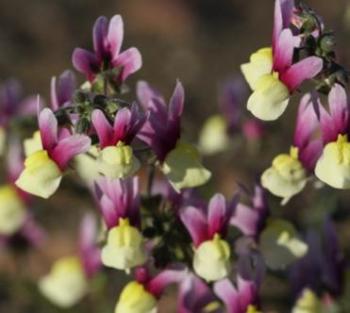
Description
Description
Nemesia suaveolens has only recently been named and described (Steiner 2009). It is an annual herb up to 320 mm high, with one or a few stems. The leaves are opposite and lanceolate, ovate or elliptical.
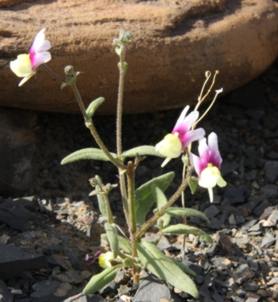
The inflorescence smells of spice and has flowers either in leaf axils or in loose, terminal racemes up to 270 mm long. The corolla is bilabiate and personate (like a snapdragon). The upper lip is erect, 4-lobed and dark magenta near the base, becoming lighter or greyish white towards the apex. An intense yellow, rectangular patch, with a touch of black, is present at the base of this lip. It probably acts as a pollen guide. The lower lip is slightly 2-lobed and intensely yellow near the base, becoming pale yellow outwards. At its base there is a raised area, the palate, formed of two parallel bulges or bosses. The corolla tube is extended into a spur that is mostly straight and narrowly conical. It is about the same length as the lower lip and is held in line with the upper lip. Flowering time is in late winter or spring, from July to September, but can be as early as May.
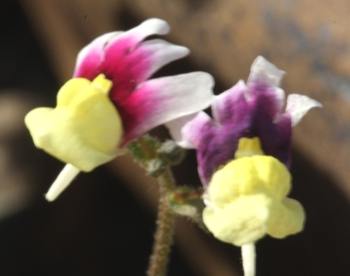
The fruit capsules are oblong to ovate, laterally flattened and light brown. The apex is clearly notched while the outer corners are rounded.
Conservation Status
Status
Nemesia suaveolens is prolific in the central Tanqua Karoo, especially after good rain. Therefore its conservation status is of 'Least Concern' (D. Raimondo pers. com.).
Distribution and habitat
Distribution description
This Nemesia grows in the Northern Cape in the Tanqua Karoo, east of the Cedarberg Mountains. It favours dry, gravelly riverbeds or stony gullies. Plants are found at altitudes of 320-445 m. The Tanqua Karoo is an arid, rain shadow region that receives only 50-70 mm of rain per annum, in autumn or early winter. When there is not enough rain, plants remain dormant as seeds.
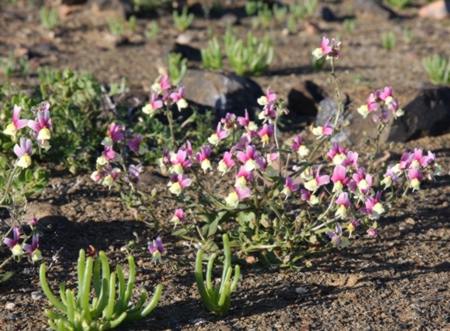
Derivation of name and historical aspects
History
The generic name Nemesia is derived from the word Nemesion, the Greek name for a similar plant; suaveolens refers to the "pleasant, spicy fragrance of the flowers" (Steiner 2009). The genus Nemesia comprises about 62 species of annual and perennial herbs, endemic to southern Africa. About 75% of these species occur in the Cape provinces and southern Namibia. By 1840 nemesias were already much prized overseas. About 120 years ago, in 1890, Hildagonda Duckett (of Hilda's Where is It? recipe book fame) sent seeds of Nemesia strumosa from the Darling area, north of Cape Town, to England. There they were hybridized and improved (Lighton 1973). They have become very popular in gardens of the whole world. More recently, plants and seeds of several other species have become available in nurseries, of both annual and perennial kinds. Nemesia fruticans is an example of the latter.
Ecology
Ecology
Nemesia suaveolens is probably pollinated by insects in the wild as they form capsules there. Steiner (2009) reported that no fruits developed in cultivation, perhaps because of the absence of a suitable pollinator. Pollen is the only reward for insects as there is no production of nectar. Insects land on the palate in such personate flowers. Even fairly small ones probably have enough weight to make the corolla lips open. This would give access to the anthers and stigma that are held in the roof of the corolla tube. (In Nemesia the lower stamens are twisted upwards so they lie next to the upper ones.) Pollen is probably deposited on the head or back of any visiting insect and should easily come in contact with the stigma of another flower as the insect pushes its way into the tube.
Uses
Use
As far as is known, Nemesia suaveolens does not as yet have any uses to man but it has much potential for horticulture. The unusual, strong colour combination of the flowers increases their appeal.
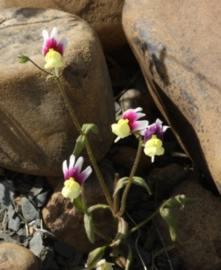
Growing Nemesia suaveolens
Grow
Information on growing other winter-rainfall annuals (mainly from Joffe & Oberholzer 2012) suggests the following methods for this Nemesia : Propagate from seed in autumn (February to April). Prepare open, sunny garden beds. (In colder gardens choose a warm, well protected position.) Add organic fertilizer and well rotted compost to well dug, easily draining, loose soil. Add a little phosphate-rich fertilizer to help with root growth. (Nemesias can grow in poor soil but will do better in a richer medium.) Water the bed the day before sowing so the soil is damp but the surface is dry. Sow seeds on a windless day as the winged seeds will blow away easily. Cover them with a thin layer of fine sand, soil or vermiculite and tamp the soil down with the back of a rake. Water gently but well and keep damp. Seeds may take between one and two weeks to germinate.
Thin the seedlings out to about 100 mm apart, when big enough to handle easily, and replant spare ones in bare areas. For a better display, apply a slow-release, high-nitrogen fertilizer soon after germination, such as 3:2:1, for leaf production. About three weeks later apply one with high potassium content, such as 3:1:5, to help with flower development. Keep on watering regularly but moderately throughout the growing and flowering periods, if there is no rain.
Alternatively, sow seed in seed trays, using a damp, well-draining, sandy medium with added fine compost and a little phosphate fertilizer. Cover lightly as above and press down. Water well but gently, then cover the trays with glass or clear plastic and place them in a sunny position. Keep damp. After germination, remove the covering. Apply fertilizer as above. When the seedlings are big enough to handle, prick them out into the garden, about 100 mm apart.
When dealing with seeds and seedlings, a useful tip is to use banana or other fruit boxes with air holes as covers for a few days. They help to keep soil damp and help young plants recover from transplanting. They can also help ward off frost. Frost cloth can also help with the last problem.
These plants would also look good scattered in groups in a rockery or as a border to a bed of perennials. Plant them in a wide, shallow pot to make a brilliant feature on a sunny stoep.
It is fashionable at present to have a meadow-type area in a garden, as shown in a number of exhibits at the 2012 Chelsea Flower Show. Several kinds of plants, of roughly similar height, were planted randomly and closely together. Here in southern Africa, we have the unique flora of the dry Northern Cape. Hence, why not create a mini-Namaqualand Spring garden with mixed small annuals in a place with lots of sun? Suitable plants to use with Nemesia suaveolens would be Cotula barbata (button flowers or gansogies), the Namaqualand daisies Dimorphotheca sinuata and D. pluvialis, Felicia dubia (dwarf felicia or sambreeltjies), Gazania lichtensteinii (wild marigold or gousblom) , Grielum humifusum (yellow satin flower or pietsnot), Nemesia ligulata (kappieblommetjie) and N. strumosa (cape jewels or wildeleeubekkie). Dorotheanthus bellidiformis (bokbaaivygie) is much shorter in height but could give a multicoloured edge to the garden. Intersperse the plants with small pebbles, sand or gravel, to create a desert-like appearance.
Don't forget to collect seeds for the next year!
References
- Germishuizen, G. & Fabian, A. 1997. Wild flowers of northern South Africa : 372. Fernwood Press, Vlaeberg.
- Joffe, P. & Oberholzer, T. 2012. Creative gardening with indigenous plants, a South African guide , edn 2: 366-375. Briza, Pretoria.
- Lighton, C. 1973. Cape Floral Kingdom : 67-72. Juta, Cape Town.
- Oliver, R. 2012. Felicia dubia . Plant of the Week Series. South African Biodiversity Institute (SANBI). : http://www.plantzafrica.com/plantefg/feliciadubia.htm
- Steiner, K.E. 2009. Two new species of Nemesia (Scrophulariaceae) from arid areas of the Northern Cape, South Africa. Bothalia 39,1: 67-72.
Credits
Julie Ready
National Herbarium, Pretoria
January 2013
Images: Marinda Koekemoer
Plant Attributes:
Plant Type: Bi/Annual
SA Distribution: Northern Cape
Soil type: Sandy
Flowering season: Spring, Winter
PH: Acid
Flower colour: Purple, Yellow, Mauve/Lilac
Aspect: Full Sun
Gardening skill: Average
Special Features:
Horticultural zones









Rate this article
Article well written and informative
Rate this plant
Is this an interesting plant?
Login to add your Comment
Back to topNot registered yet? Click here to register.